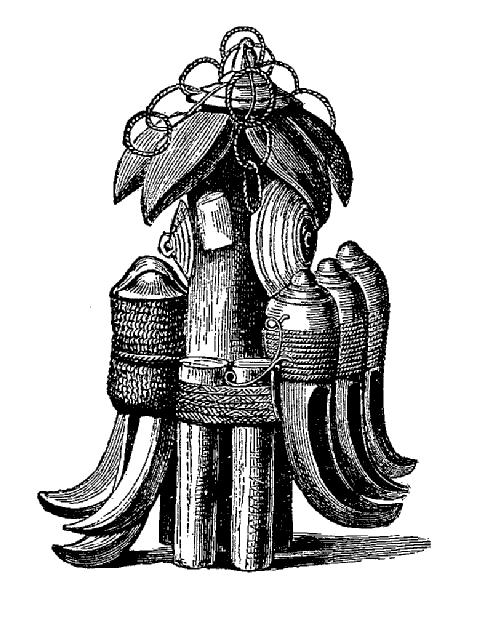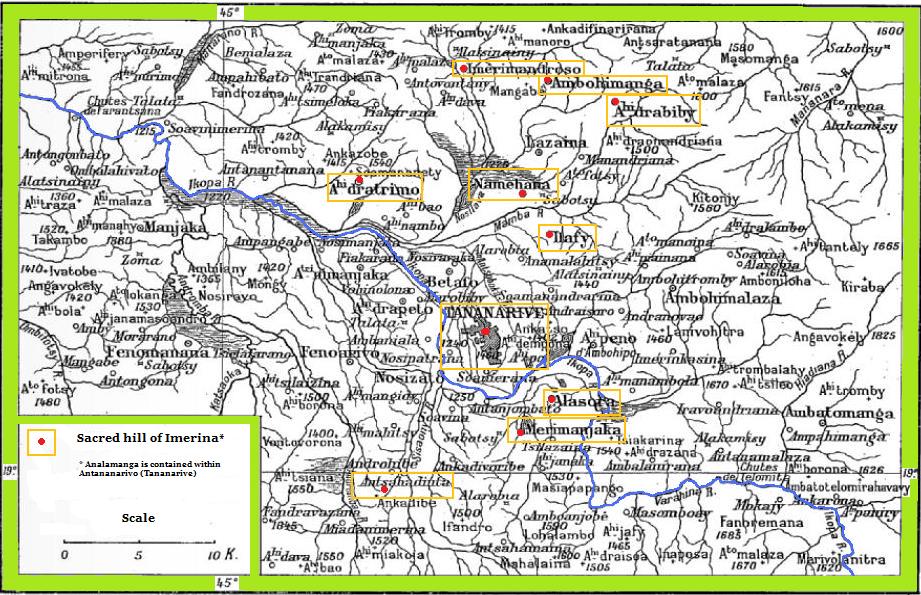|
Ralambo
Ralambo was the ruler of the Kingdom of Imerina in the central Highlands region of Madagascar from 1575 to 1612. Ruling from Ambohidrabiby, Ralambo expanded the realm of his father, Andriamanelo, and was the first to assign the name of Imerina to the region. Oral history has preserved numerous legends about this king, including several dramatic military victories, contributing to his heroic and near-mythical status among the kings of ancient Imerina. The circumstances surrounding his birth, which occurred on the highly auspicious date of the first of the year, are said to be supernatural in nature and further add to the mystique of this sovereign. Oral history attributes numerous significant and lasting political and cultural innovations to King Ralambo. He is credited with popularizing the consumption of beef in the Kingdom of Imerina and celebrating this discovery with the establishment of the ''fandroana'' New Year's festival which traditionally took place on the day of Ral ... [...More Info...] [...Related Items...] OR: [Wikipedia] [Google] [Baidu] |
Imerina
The Merina Kingdom, or Kingdom of Madagascar, officially the Kingdom of Imerina (–1897), was a pre-colonial state off the coast of Southeast Africa that, by the 19th century, dominated most of what is now Madagascar. It spread outward from Imerina, the Central Highlands region primarily inhabited by the Merina ethnic group with a spiritual capital at Ambohimanga and a political capital west at Antananarivo, currently the seat of government for the modern state of Madagascar. The Merina kings and queens who ruled over greater Madagascar in the 19th century were the descendants of a long line of hereditary Merina royalty originating with Andriamanelo, who is traditionally credited with founding Imerina in 1540. In 1883, France invaded the Merina Kingdom to establish a protectorate. France invaded again in 1894 and conquered the kingdom, making it a French colony, in what became known as the Franco-Hova Wars. History Hova-Vazimba conflict Madagascar's central highlands ... [...More Info...] [...Related Items...] OR: [Wikipedia] [Google] [Baidu] |
Andrianjaka
Andrianjaka reigned over the Kingdom of Imerina in the central highlands region of Madagascar from around 1612 to 1630. Despite being the younger of King Ralambo's two sons, Andrianjaka succeeded to the throne on the basis of his strength of character and skill as a military tactician. The most celebrated accomplishment of his reign was the capture of the hill of Analamanga from a Vazimba king. There he established the fortified compound (''rova'') that would form the heart of his new capital city of Antananarivo. Upon his orders, the first structures within this fortified compound (known as the Rova of Antananarivo) were constructed: several traditional royal houses were built, and plans for a series of royal tombs were designed. These buildings took on an enduring political and spiritual significance, ensuring their preservation until being destroyed by fire in 1995. Andrianjaka obtained a sizable cache of firearms and gunpowder, materials that helped to establish and preserve ... [...More Info...] [...Related Items...] OR: [Wikipedia] [Google] [Baidu] |
Andriamanelo
Andriamanelo ( ''fl.'' 1540–1575) was king of Alasora in the central highlands region of Madagascar. He is generally considered by historians to be the founder of the Kingdom of Imerina and originator of the Merina royal line that, by the 19th century, had extended its rule over virtually all of Madagascar. The son of a Vazimba mother and a man of the newly arrived Hova people originating in southeast Madagascar, Andriamanelo ultimately led a series of military campaigns against the Vazimba, beginning a several-decade process to drive them from the Highlands. The conflict that defined his reign also produced many lasting innovations, including the development of fortified villages in the highlands and the use of iron weapons. Oral tradition furthermore credits Andriamanelo with establishing a ruling class of nobles ('' andriana'') and defining the rules of succession. Numerous cultural traditions, including the ritual of circumcision, the wedding custom of ''vodiondry'' a ... [...More Info...] [...Related Items...] OR: [Wikipedia] [Google] [Baidu] |
Sampy
A sampy is an amulet or idol of spiritual and political importance among numerous ethnic groups in Madagascar. Amulets and idols fashioned from assorted natural materials have occupied an important place among many Malagasy communities for centuries. ''Ody'', personal amulets believed to protect or allocate powers to the wearer, were commonplace objects possessed by anyone from slave children to kings. The name ''sampy'' was given to those amulets that, while physically indistinguishable from ''ody'', were distinct in that their powers extended over an entire community. The ''sampy'' were often personified - complete with a distinct personality - and offered their own house with keepers dedicated to their service. In the sixteenth century, King Ralambo of the Merina people amassed twelve of the most reputed and powerful ''sampy'' from neighboring communities. He furthermore transformed the nature of the relationship between ''sampy'' and ruler: whereas previously the ''sampy'' ha ... [...More Info...] [...Related Items...] OR: [Wikipedia] [Google] [Baidu] |
Sampy Talisman Idol Madagascar
A sampy is an amulet or idol of spiritual and political importance among numerous ethnic groups in Madagascar. Amulets and idols fashioned from assorted natural materials have occupied an important place among many Malagasy communities for centuries. ''Ody'', personal amulets believed to protect or allocate powers to the wearer, were commonplace objects possessed by anyone from slave children to kings. The name ''sampy'' was given to those amulets that, while physically indistinguishable from ''ody'', were distinct in that their powers extended over an entire community. The ''sampy'' were often personified - complete with a distinct personality - and offered their own house with keepers dedicated to their service. In the sixteenth century, King Ralambo of the Merina people amassed twelve of the most reputed and powerful ''sampy'' from neighboring communities. He furthermore transformed the nature of the relationship between ''sampy'' and ruler: whereas previously the ''sampy'' ha ... [...More Info...] [...Related Items...] OR: [Wikipedia] [Google] [Baidu] |
Andriana
Andriana refers to both the noble class and a title of nobility in Madagascar. Historically, many Malagasy ethnic groups lived in highly stratified caste-based social orders in which the ''andriana'' were the highest strata. They were above the Hova (free commoner castes) and Andevo (slaves). The Andriana and the Hova were a part of ''Fotsy'', while the Andevo were ''Mainty'' in local terminology. The Andriana strata originally constituted the nobility, warrior, and land owning class of the Merina society. They were endogamous and their privileges were institutionally preserved. While the term and concept of Andriana is studied with the Merina people of Madagascar, the term is not limited to them. The use of the word "Andriana" to denote nobility occurs among numerous other Malagasy ethnic groups such as the Betsileo, the Betsimisaraka, the Tsimihety, the Bezanozano, the Antambahoaka and the Antemoro. ''Andriana'' often traditionally formed part of the names of Malagasy kin ... [...More Info...] [...Related Items...] OR: [Wikipedia] [Google] [Baidu] |
Fandroana
The Fandroana, termed the Royal Bath by 19th century European historians, is the annual New Year's festival of the Merina people inhabiting the highlands of central Madagascar. The origins of the festival are preserved through oral history. According to folk legend, the wild zebu cattle that roamed the Highlands were first domesticated for food in Imerina under the reign of Ralambo. Different legends attribute the discovery that zebu were edible to the king's servant or to Ralambo himself. Ralambo is credited with founding the traditional ceremony of the fandroana to celebrate this discovery, although others have suggested he merely added certain practices to the celebration of a long-standing ritual. History According to one version of the story, while traversing the countryside Ralambo and his men came across a wild zebu so exceptionally fat that the king decided to make a burnt offering of it. As the zebu flesh cooked, the enticing smell led Ralambo to taste the meat. He declar ... [...More Info...] [...Related Items...] OR: [Wikipedia] [Google] [Baidu] |
Twelve Sacred Hills Of Imerina
The twelve sacred hills of Imerina are hills of historical significance to the Merina people of Madagascar. Located throughout Imerina, the central area of the highlands of Madagascar, the sites were often ancient capitals, the birthplaces of key public figures, or the tomb sites of esteemed political or spiritual leaders. The first set of sacred sites was designated by early 17th-century king Andrianjaka. The notion was re-sanctified under late 18th-century king Andrianampoinimerina, who replaced several of the earlier sites with new ones. More than 12 sites were thus designated as sacred over time, although the notion of twelve sacred hills was perpetuated because of the significance of the number 12 in Malagasy cosmology. Today, little concrete evidence of the former importance of many of these sites remains, but the significant archeological and cultural heritage of several of the sites has been preserved. The historic significance of the sites is best represented by the R ... [...More Info...] [...Related Items...] OR: [Wikipedia] [Google] [Baidu] |
Vazimba
The Vazimba (Malagasy ), according to popular belief, were the first inhabitants of Madagascar. While beliefs about the physical appearance of the Vazimba reflect regional variation, they are generally described as smaller in stature than the average person, leading some scientists to speculate that they may have been a pygmy people (and therefore a separate Malagasy ethnic group) who migrated from the islands that constitute modern-day Indonesia and settled in Madagascar over the course of the period between 350 BCE–500 CE. Scientific evidence confirms the first arrival and subsequent increase of human settlers on the island during this period, but the pygmy theory has not been proven. Stories about the Vazimba form a significant element in the cultural history and collective identity of the Malagasy people, ranging from the historical to the supernatural, inspiring diverse beliefs and practices across the island. They have analogs in some other Austronesian cultures, inc ... [...More Info...] [...Related Items...] OR: [Wikipedia] [Google] [Baidu] |
List Of Imerina Monarchs
This article lists the Imerina monarchs, from the earliest origins of the Merina monarchy until the French conquest of the Merina Kingdom during the Second Madagascar expedition. Early monarchs in the Merina line Below is a list of the line of Merina monarchs that ruled in the Central Highlands of Madagascar and from whom were issued the first true monarchs of a united Madagascar in the 19th century. Before the uniting of Madagascar, succession was based on the current monarch's designation of an heir, typically from among his or her own children. As such, the list below represents a direct genealogical line from the last 19th-century queen of Madagascar to some of the earliest known rulers identified in the 15th century or before. Prior to the 16th century, detailed information about the names and dates of Merina rulers becomes less consistent. Genealogy in this early period are derived primarily from oral history, while later names and dates are verifiable from primary so ... [...More Info...] [...Related Items...] OR: [Wikipedia] [Google] [Baidu] |
Merina People
The Merina people (also known as the Imerina, Antimerina, or Hova) are the largest ethnic group in Madagascar.Merina people Ethnic Groups of Madagascar Encyclopædia Britannica They are the "highlander" Malagasy ethnic group of the African island and one of the country's eighteen official ethnic groups. Their origins are mixed, predominantly with |
Ikopa River
The Ikopa River is the second longest waterway in Madagascar and passes through the capital, Antananarivo. It is the largest tributary of the Betsiboka River Betsiboka River is a long river in central-north Madagascar. It flows northwestward and empties to Bombetoka Bay, forming a large delta. It originates to the east of Antananarivo. The river is surrounded in mangroves. The river is distinctive fo .... It is formed by the Varahina-North and Varahina-South Rivers. Its spring, named Varahina, is found in the sub-prefecture of Andramasina at an altitude of 1810 meters. References Rivers of Madagascar Rivers of Analamanga {{Madagascar-river-stub ... [...More Info...] [...Related Items...] OR: [Wikipedia] [Google] [Baidu] |








